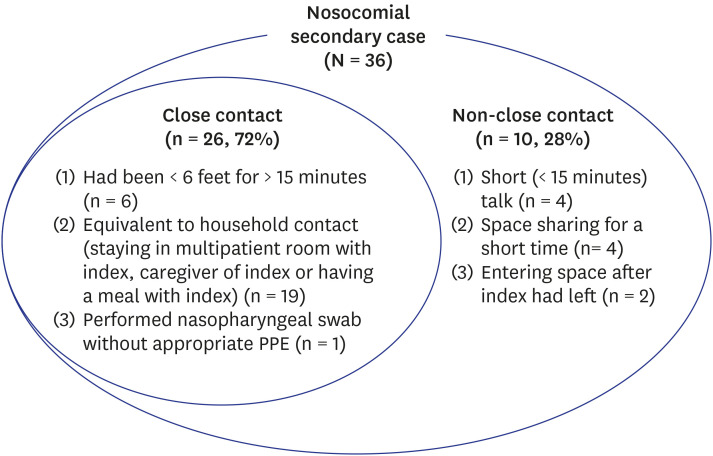J Korean Med Sci.
2021 Aug;36(33):e233. 10.3346/jkms.2021.36.e233.
Frequent Occurrence of SARS-CoV-2 Transmission among Non-close Contacts Exposed to COVID-19 Patients
- Affiliations
-
- 1Department of Infectious Diseases, Asan Medical Center, University of Ulsan College of Medicine, Seoul, Korea
- 2Office for Infection Control, Asan Medical Center, Seoul, Korea
- 3Department of Microbiology, Institute for Viral Diseases, Biosafety Center, College of Medicine, Korea University, Seoul, Korea
- 4Department of Laboratory Medicine, Asan Medical Center, University of Ulsan College of Medicine, Seoul, Korea
- KMID: 2519354
- DOI: http://doi.org/10.3346/jkms.2021.36.e233
Abstract
- Severe acute respiratory syndrome coronavirus 2 (SARS-CoV-2) transmission among non-close contacts is not infrequent. We evaluated the proportion and circumstances of individuals to whom SARS-CoV-2 was transmitted without close contact with the index patient in a nosocomial outbreak in a tertiary care hospital in Korea. From March 2020 to March 2021, there were 36 secondary cases from 14 SARS-CoV-2 infected individuals. Of the 36 secondary cases, 26 (72%) had been classified as close contact and the remaining 10 (28%) were classified as non-close contact. Of the 10 non-close contact, 4 had short conversations with both individuals masked, 4 shared a space without any conversation with both masked, and the remaining 2 entered the space after the index had left. At least one quarter of SARSCoV-2 transmissions occurred among non-close contacts. The definition of close contact for SARS-CoV-2 exposure based on the mode of droplet transmission should be revised to reflect the airborne nature of SARS-CoV-2 transmission.
Keyword
Figure
Cited by 1 articles
-
Risk of Severe Acute Respiratory Syndrome Coronavirus 2 (SARS-CoV-2) Transmission Among Healthcare Workers Dining in Hospital Staff Cafeterias
Jiwon Jung, Young-Ju Lim, Eun Ok Kim, Sung-Han Kim
J Korean Med Sci. 2021;37(2):e14. doi: 10.3346/jkms.2022.37.e14.
Reference
-
1. Center for Disease Control and Prevention. Case investigation & contact tracing guidance. Appendices. Accessed May 17, 2021. https://www.cdc.gov/coronavirus/2019-ncov/php/contact-tracing/contact-tracing-plan/appendix.html#contact.2. Center for Disease Control and Prevention. Contact tracing for COVID-19. Accessed May 17, 2021. https://www.cdc.gov/coronavirus/2019-ncov/php/contact-tracing/contact-tracing-plan/contact-tracing.html.3. Mack CD, Wasserman EB, Perrine CG, MacNeil A, Anderson DJ, Myers E, et al. Implementation and evolution of mitigation measures, testing, and contact tracing in the national football league, August 9–November 21, 2020. MMWR Morb Mortal Wkly Rep. 2021; 70(4):130–135. PMID: 33507889.
Article4. Klompas M, Baker MA, Rhee C, Tucker R, Fiumara K, Griesbach D, et al. A SARS-CoV-2 cluster in an acute care hospital. Ann Intern Med. 2021; 174(6):794–802. PMID: 33556277.
Article5. Greenhalgh T, Jimenez JL, Prather KA, Tufekci Z, Fisman D, Schooley R. Ten scientific reasons in support of airborne transmission of SARS-CoV-2. Lancet. 2021; 397(10285):1603–1605. PMID: 33865497.
Article6. Baruniuk C.Covid-19: What do we know about airborne transmission of SARS-CoV-2? BMJ. 2021; 373:n1030. PMID: 33888460.
Article7. Allen JG, Ibrahim AM. Indoor air changes and potential implications for SARS-CoV-2 transmission. JAMA. 2021; 325(20):2112–2113. PMID: 33861316.
Article8. Samet JM, Prather K, Benjamin G, Lakdawala S, Lowe JM, Reingold A, et al. Airborne transmission of severe acute respiratory syndrome coronavirus 2 (SARS-CoV-2): what we know. Clin Infect Dis. Forthcoming. 2021; DOI: 10.1093/cid/ciab039.
Article9. Kwon KS, Park JI, Park YJ, Jung DM, Ryu KW, Lee JH. Evidence of long-distance droplet transmission of SARS-CoV-2 by direct air flow in a restaurant in Korea. J Korean Med Sci. 2020; 35(46):e415. PMID: 33258335.
Article10. Jung J, Lee J, Jo S, Bae S, Kim JY, Cha HH, et al. Nosocomial outbreak of COVID-19 in a hematologic ward. Infect Chemother. 2021; 53(2):332–341. PMID: 34216126.
Article11. Oran DP, Topol EJ. The proportion of SARS-CoV-2 infections that are asymptomatic : a systematic review. Ann Intern Med. 2021; 174(5):655–662. PMID: 33481642.12. Johansson MA, Quandelacy TM, Kada S, Prasad PV, Steele M, Brooks JT, et al. SARS-CoV-2 transmission from people without COVID-19 symptoms. JAMA Netw Open. 2021; 4(1):e2035057. PMID: 33410879.
Article13. Bender JK, Brandl M, Höhle M, Buchholz U, Zeitlmann N. Analysis of asymptomatic and presymptomatic transmission in SARS-CoV-2 outbreak, Germany, 2020. Emerg Infect Dis. 2021; 27(4):1159–1163.
Article14. World Health Organization. Contact tracing in the context of COVID-19. Accessed July 22, 2021. https://www.who.int/publications/i/item/contact-tracing-in-the-context-of-covid-19.15. Center for Disease Control and Prevention. Science brief: SARS-CoV-2 and surface (fomite) transmission for indoor community environments. Accessed April 5, 2021. https://www.cdc.gov/coronavirus/2019-ncov/more/science-and-research/surface-transmission.html.16. Korea Disease Control and Prevention Agency. Update: current status and characteristics of variant virus outbreak in Korea in March 2021. Public Health Wkly Rep. 2021; 14(18):1099–1118.17. The New York Times. C.D.C. internal report calls delta variant as contagious as chickenpox. Accessed August 4, 2021. https://www.nytimes.com/2021/07/30/health/covid-cdc-delta-masks.html.
- Full Text Links
- Actions
-
Cited
- CITED
-
- Close
- Share
- Similar articles
-
- COVID-19 and Breastfeeding
- Clinical implications of coronavirus disease 2019 in neonates
- Risk and prevention of COVID-19 in ophthalmic practice
- Vaccine Effect on Household Transmission of Omicron and Delta SARS-CoV-2 Variants
- Epidemiology, Virology, and Clinical Features of Severe Acute Respiratory Syndrome Coronavirus 2 (SARS-CoV-2; Coronavirus Disease-19)


